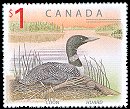|
Canadian
Wildlife Series: Loon and Polar Bear
Continuing the Canadian Wildlife series
launched in 1997, Canada Post issued two new high-value definitives - a
one-dollar Loon stamp and a two-dollar Polar Bear stamp in 1998
 
.
| |
Loon
|
Polar Bear
|
| Day of Issue |
27 October 1998
|
| Denomination |
$1.00
|
$2.00
|
| Layout |
Pane of 16
|
| Design |
Stephen Slipp
|
| Art |
Robert Ralph Carmichael
|
Brent Townsend
|
| Engraving |
Jorge Peral
|
Martin Mörck
|
| Printer |
Canadian Bank Note
|
| Quantity |
11,500,000
|
11,500,000
|
| Dimensions |
48 mm x 40 mm (horizontal)
|
| Perforation |
13+
|
| Gum Type |
P.V.A.
|
| Paper Manufacturer |
Coated one side, gravure
|
| Printing |
Lithography (three colours)
Intaglio (two colours)
|
Lithography (three colours)
Intaglio (one colour)
|
| Tagging |
No Tag
|
The Loon
Featured on Canada's dollar coin, the loon is a large diving bird that
lives in either fresh or salt water. Loons feed mainly on fish which they
catch by swimming underwater - sometimes down to depths of 70 metres. By
compressing their plumage to release air and by forcing air from their
lungs, loons are able to ride low in the water with only their bills and
eyes above the surface. Positioned far back on their bodies, loons' legs
are strong water propellers, but they make walking on land awkward. Though
they are strong flyers, loons cannot take off from land and must make running
starts across the water surface to build speed. Most loons come ashore
only for nesting. The common loon is the second largest species of loon
in Canada and is characterized by its large size and a sharply pointed
bill unlike that of ducks, geese or swans.
The Polar Bear
Half of the world's 40,000 polar bears live in Canada - in the coastal
regions of both the Northwest Territories and the Yukon, and in Manitoba,
Ontario and arctic Quebec. As their Latin name ursus maritimus suggests,
polar bears are maritime creatures. They spend most of their days out on
sea ice, hunting seals.Though they are believed to have evolved from grizzlies,
polar bears have unique rounded shoulders and pronounced brow ridges. Their
necks, skulls and noses are elongated and their muzzles are aquiline. Large
paws help polar bears distribute their weight while walking on thin ice.
Their front legs act as water propellers while their hind limbs function
as rudders.
One of the most distinctive features of the polar bear is its colour.
The white fur helps it blend into the arctic background and has special
features for cold weather adaptation; it is transluscent and transmits
ultraviolet radiation to keep the skin warm. Equally distinctive is the
polar bear's size. The largest carnivore in the world that lives mostly
out of water, it can weigh up to 800 kg - double the size of a grizzly!
The Stamps
Designed by Steven Slipp of Halifax, the Loon and Polar definitives
are wonderful wildlife issues that combine both modern and traditional
printing techniques - intaglio for the animal portraits and offset lithography
for the background colours. The halftone dot of the litho portion is made
from a small icon image of each animal, providing one of several hidden
security features.
Information from Canadian Stamp Details
|